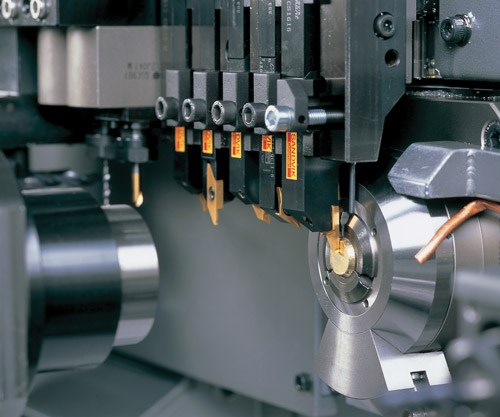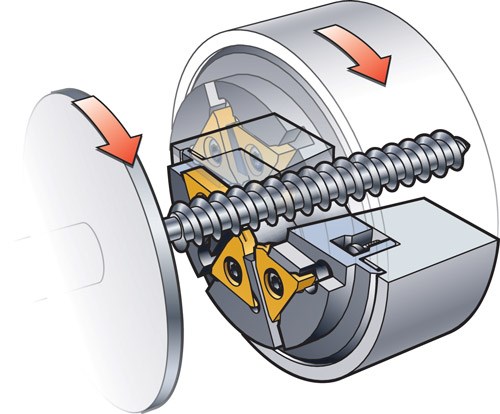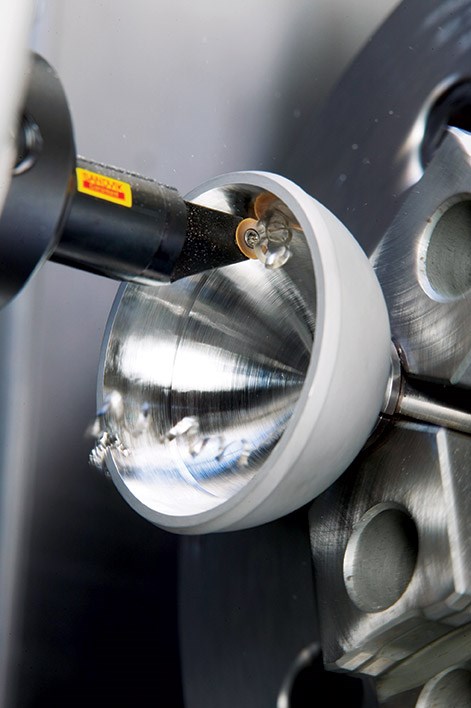Tooling Up for Micromachining
Choosing the right tools and matching them to the correct operations and process techniques for micromachining applications is critical to success in this burgeoning market.
In micromachining, the parts may be small, but the tooling and machining options are wide open. And with all of the challenges that come with micromachining—tight tolerances, stringent quality demands, hard-to-machine materials—choosing the right methods is critical.
An optimized small-parts machining plan can save component materials, reduce cycle times, decrease tooling costs, decrease idle machine time and increase the quality of the components.
As technologies continue to advance, it’s important to have a solid tooling partner that can lend the application support and consultation to help increase the productivity of small-parts operations. Often times, the industry and type of application are a good place to start when it comes to identifying process improvements.
Electronic and Telecommunications
The components necessary for electronics and telecom products are myriad, but the challenges in machining them are the same: high-volume production demands and the need for extremely high component quality and surface finish. What’s more, the pressure on cost-cutting is extremely high in an industry in which technologies evolve at a breakneck pace.
Increasingly, hard-to-machine materials such as low carbon and alloyed steels are necessary thanks to higher demands on the function of electronic components and present yet another obstacle to these operations. Extra-small turning tools work well in many electronic component applications including CD tray details, which often involve internal turning, grooving, parting and threading operations.
Because precision is of the essence, it’s critical to choose tools with inserts that have a secure clamping system that guarantees correct positioning of the cutting edge. When using these turning tools, it’s best to start at a low feed to ensure insert security and surface finish, and then increase the feed rate to improve chipbreaking. Also, a cutting depth larger than the nose radius should be used to minimize the radial deflection of the insert—a common issue in internal machining.
Sandvik Coromant’s line of CoroTurn XS are often ideal in these types of internal turning, grooving and threading applications, and provide improved chip evacuation in small holes, a secure machining process, longer tool life thanks to less chip re-cutting, and work for hole diameters as small as 0.012 inch (0.3 mm). The system also offers more secure insert clamping, which allows for longer overhangs and a resulting increase in productivity.
Medical
Medical component manufacturers face many of the same challenges as electronic component manufacturers. Because of the high demand for medical and dental components, manufacturers must produce more quickly, cost-effectively and predictably. Component quality and high corrosion resistance is of the utmost importance, and the most commonly called for materials—titanium and cobalt chromium alloys—are very difficult to machine.
A common element of many medical components is intricate and varied thread forms with very high tolerances. Bone screws often present the challenge of a high aspect ratio (the screw is much longer than it is thick), making operations even more difficult because the screw easily bends during machining. Additionally, many screws now require wider helix angles, which are more difficult to machine with single-point threading tools.
Thread whirling—a milling process in which the tool’s cutting edges are on the inside of the cutter ring rather than the outside—is a much more productive process. The process is best suited for CNC Swiss-type lathes because of the short distance between the cutter and the guide bush, which provides increased support and minimizes vibration.
Manufacturers should choose a thread whirling ring with inserts that mount at a differential pitch (the inserts are not equidistant) in order to address chatter—one of the biggest potential problems in thread whirling—and extend tool life. Whirling ring inserts take a beating because of the tough materials they machine, so choose inserts that offer a hard, fine-grained substrate with a wear-resistant coating to prolong tool life and optimize surface finish.
The CoroMill 325 thread whirling rings and inserts are compatible with most sliding head machines and thread whirling spindle units and are well applied for threading long, slender components. Designed for screw diameters 0.118 to 0.394 inch (3 to 10 mm), the whirling rings are also available in GC1105—a tough grade designed for medical machining. These inserts provide sharper edges and a burr-free finish, enabling longer, more continuous runs and higher productivity.
When it comes to machining dental components such as tooth implants, superior performance and accuracy are imperative. Small ballnose end mills are ideal for small-parts profiling because they work well in tight corners and long reaches. With excellent heat resistance and high accuracy, these end mills are also suitable in die and mold operations. As with thread whirling tooling, look for tough grades to combat hard steels.
The geometry design of CoroMill Plura ballnose end mills prevents their radius from deteriorating because of uneven wear, with edge preparation also provided for improved wear behavior. Small diameters down to 0.004 inch (0.1 mm) and a long neck on the tool allows for long reach and good accessibility, especially in pocket milling.
The GC1700 is a fine-grained solid carbide grade with multi-layered PVD coating for high hardness and high wear resistance. Physical vapor deposition, or PVD, is an application process that creates a very thin coating, resulting in a sharper cutting edge. This makes the tool ideal for small part applications in medium-hard to hard steels, 35-72HRc.
Aerospace
In this industry the right or wrong holding system can seriously hamper or improve machining productivity, especially when it comes to tough materials. Because of the materials involved, medical and aerospace manufacturing applications, in particular, call for large-volume insert use. The resulting time spent indexing inserts can be a huge drain on productivity over time.
What’s more, small-parts machining of the demanding, long-chipping materials that aerospace manufacturers typically use creates problems with chipbreaking.
The QS Holding System with high precision coolant not only reduces setup and tool change times, but also improves chipbreaking and performance. Its wedge design allows manufacturers to remove and change inserts in seconds. The precision nozzles deliver accurate coolant flow, improving component quality and chipbreaking. Benefits can be seen with coolant pressure as low as 145 psi.
A machining technique—helical milling or ramping—can increase productivity in aerospace applications. The technique uses milling tools rather than drills to more efficiently machine holes and pocket features on the curved and slanted plains common in many aerospace components. By taking relatively light and fast cuts, the technique requires significantly less force and power compared with a drill.
The CoroMill 326 and CoroMill 327 are used for this technique for small-parts machining, and provide high metal removal rates with multiple, sharp cutting edges; a long reach; and strong wear-resistance.
Automotive
Many automotive components are made by stamping dies to form the body parts of cars from sheet metal—think doors, hoods, fenders, and so on. But there are also high-volume, small-part automotive components such as transmission shafts and gears. Cost per component is the main objective of these mass production components. Key success factors for seamless production include process security, rapid cycle times and high quality.
Steel turning dominates shaft and gear manufacturing. However, it is important to be careful when selecting the right insert grade for steel turning, as it will pave the way for more efficient hard part turning with less stock required if grinding is required, ultimately resulting in a lower cost per part.
Sandvik Coromant’s GC4225 grade is designed to deliver secure, reliable and predictable cutting performance. The inserts feature optimized geometries that maximize surface finishes, productivity and secure very close dimensional tolerances.
Traditionally, a transmission component goes from turning operations into grinding operations, but moving next into hard part turning instead can significantly improve productivity. This process meets the automotive industry’s demand for higher productivity, delivering higher quality and shorter cycle times. In addition, the ability to run without coolant makes hard part machining more cost efficient than grinding.
A new package of optimized wiper inserts and grades like cubic boron nitride (CBN), address the hard part turning needs in transmission production. CB7015 is an optimized wiper insert, designed to accelerate finish turning of case-hardened transmission components. It features a multi-corner locking technology that contains mechanically interlocking CBN corners brazed far from the hot cutting zone, providing strength and security compared with conventional tip designs. The mechanically interlocking corners withstand the pressures brought on by the feed, depth of cut, and interrupted cutting, making it a strong choice for balancing surface and dimensional tolerance with productivity demands.
Explore the Options
Micromachining presents a unique set of challenges—not only because of the size of the workpieces, but also because of the hard-to-machine materials and geometries inherent in the industries that demand these parts. To compound the challenge, the medical, aerospace and electronics industries are becoming more competitive and technologically demanding—with the need for high-volume production and a sizeable tooling and insert investment.
While choosing the right tooling and machining processes may seem daunting, valuable resources exist to help manufacturers make the most of their small-parts machining. As the playing field becomes more cut throat, staying ahead of the curve with the latest tools and techniques to enhance productivity can make or break a manufacturing business. But with the right partner, success is easily within reach.
Related Content
Making Micro Threads
Production of micro threads can be challenging, but using the most suitable tools for a given application can simplify the task.
Read MoreBroaching Tool Technology For Lathes Used to Slot Inconel Parts
This shop finds value in using an indexable-insert-style broaching tool to create blind-hole slots in heat-treated Inconel aerospace parts on a CNC lathe.
Read MoreTool Path Improves Chip Management for Swiss-Type Lathes
This simple change to a Swiss-type turning machine’s tool path can dramatically improve its ability to manage chips.
Read MoreWhat Is Trochoidal Turning? How Might Shops Benefit From It?
While trochoidal milling might be a more well-known toolpath strategy, trochoidal turning can offer similar benefits such as high material removal rates especially for rough-turning operations.
Read MoreRead Next
A Tooling Workshop Worth a Visit
Marubeni Citizen-Cincom’s tooling and accessory workshop offers a chance to learn more about ancillary devices that can boost machining efficiency and capability.
Read MoreEmerging Leaders Nominations Now Open
Here’s your chance to highlight a young person in your manufacturing business who is on the path to be a future leader moving your company forward.
Read More5 Aspects of PMTS I Appreciate
The three-day edition of the 2025 Precision Machining Technology Show kicks off at the start of April. I’ll be there, and here are some reasons why.
Read More











.png;maxWidth=300;quality=90)














